 This narrative focusses on Jenny, Di and Roy’s Grandfather – James William Bradford. It is one that is full of mystery, tinged with quite probably, a lot of sadness. The challenge is that in a relatively short life it is difficult to know exactly where to start. I’ve decided to jump-in and see James at the age of 11 and then try and piece together his life from that point. By the time you’ve read this, you’ll realise it’s more about the people around him, rather than James himself; but they’re the ones that make his story.
This narrative focusses on Jenny, Di and Roy’s Grandfather – James William Bradford. It is one that is full of mystery, tinged with quite probably, a lot of sadness. The challenge is that in a relatively short life it is difficult to know exactly where to start. I’ve decided to jump-in and see James at the age of 11 and then try and piece together his life from that point. By the time you’ve read this, you’ll realise it’s more about the people around him, rather than James himself; but they’re the ones that make his story.At the age of 11 James was to be found in the Union Workhouse in Alnwick with his sister Jane (Margaret Jane). She was a couple of years older than him having been born in 1886 on 20th December in Whitburn, Marsden, Co. Durham – her father George Marshall Bradford being described on the birth certificate as an iron moulder, and presumably working at the nearby colliery. Her mother was Mary Ann Bradford (nee Watson).

So the first piece of the story (from the 1881 census) has George and Mary setting-up home in Clayport Street, Alnwick after their marriage in April 1879; George working as an iron founder and then deciding to try their luck further south where the coal was being mined at Whitburn Colliery. They moved to Marsden Village and then … did George have an accident? I believe so. This would explain why they then over the next 10 years moved northwards back towards Alnwick. Why do I believe this to be the case? Well because George himself was also in the Union Workhouse in Alnwick in 1901 – that is where he died on the 24th March 1901. Was George being treated there – he died of epilepsy and phlebitis – or was he there because he was a pauper. I’m afraid it’s almost certainly the latter. But what had happened to his wife – Mary Ann? There’s no record of her in the Workhouse in the 1901 census and yet her daughter Jane, and son James are there. Quite a mystery.
This “disappearance” of Mary Ann has been something that I haven’t been able to get my head around for a few years. She doesn’t appear in the 1901 census; she wasn’t in the workhouse; she hadn’t died prior to 1901 – which might very well explain why two of her children were in the workhouse in 1901 as their father was unwell. Moreover I can’t find any record of her dying after 1901 either! So what really happened to Mary Ann?
A chance discussion with another family history researcher in Australia has thrown light on the problem and has, I think, given us an answer. Her link to the Bradford Family tree came through her grandmother Elizabeth. I had up to this time assumed that Elizabeth had died in 1891 – that would explain why she wasn’t on the census return for 1901. I had even got a death certificate for “her” and noted that her mother had reported the death, and her name was Mary. It all seemed to fit but of course it didn’t. It was just a pure coincidence, I had not connected the fact that Mary Ann would have recorded the death of Elizabeth in Morpeth where they were living in 1891, not Alnwick. Moreover, this Mary was described as a seamstress. “Our” Mary Ann never had an occupation recorded.
So … this Australian grand-daughter of Elizabeth has really changed things. Elizabeth (Lizzie) Bradford got married to Robert Armstrong on 5 June 1904 at The Venerable Bede Church on Sunderland Road, Gateshead [the original church has been demolished but the church is still there in what had been the church hall.] Guess who one of the witnesses to the wedding was? It was Jane Bradford, almost certainly James and Elizabeth’s sister, who unfortunately didn’t live much longer dying in January 1911 in Gateshead.
Now knowing that Elizabeth was alive in 1901, and that she called herself Lizzie – was there a Lizzie Bradford of the right age, and born in Alnwick, on a census return for 1901? Indeed there was in the Stephenson’s Arms at Wylam living with a Samuel Coope and Mary Ann Coope (born in Alnwick). She was described as Samuel’s sister-in-law (but with daughter -in-law crossed out !!!!!!). Can you see where I’m heading?
I think it’s highly probable that Mary Ann Coope and Mary Ann Bradford (nee Watson) are one and the same person. Elizabeth was indeed her daughter but Samuel would not have been sure how to describe her relationship to him as they were not in fact man and wife. There is a no record of a marriage between Samuel Coope and anyone from Alnwick, before Mary Ann Coope’s death in July 1909, in the period from 1881 to 1901.
[Update: Mary Ann Coope’s death certificate has not returned any information that confirms her identity as she died “a tramper” at Chevington Moor Farm, near Morpeth sometime before 13th July 1909. The circumstantial evidence is however very strong with the 1901 census showing both hers (and Lizzie Bradford’s) place of birth and year of birth as being in line with what would be expected if she was indeed Mary Ann Bradford.]
Lizzie (as recorded on her marriage certificate) went on to marry Robert Armstrong. After their marriage in Gateshead, they had six children and were living in Bellingham in 1911; he died in France in 1917. She (Elizabeth Bradford) married again (George Walker) in 1919 and died in Gateshead in on 27th January 1960. On her death certificate her father George (that would be Bradford) is described as a moulder. I think it’s fair to say that your dad had an aunt living in Gateshead who he didn’t know anything about. Isn’t that sad?
As for James, we left him in the workhouse in 1901. His sister Jane would have left before he did and she probably moved to Gateshead where she was in contact with her sister, Elizabeth at the time of Lizzie’s wedding in 1904 and would have been until her death in 1911. Whether he followed them to Gateshead we don’t know. We do know that he joined the Durham Light Infantry before the War in 1907 and it was the Army that gave him an education that enabled him to rise through the ranks to be Company Sergeant Major. We do know that he married Joannah Bell on 24th August 1913 at Christchurch, Gateshead. We also know a little about his war record and his death as a consequence of being gassed in 1918, on 2nd February 1921. Whether he knew his sister Elizabeth was also living in Gateshead at that time, we’ll never know. That’s a bit sad too.
Original Source Documents
The Census Records can be viewed from Ancestry, as can a few other photos and records.
Birth Certificate. George Marshall Bradford 1849.
Birth Certificate. Elizabeth “Lizzie” Bradford 1881.
Birth Certificate. Margaret Jane Bradford 1886.
Birth Certificate. James William Bradford 1889.
Death Certificate. George Marshall Bradford 1901.
Death Certificate. Margaret Jane Bradford 1911.
Death Certificate. James William Bradford 1921.
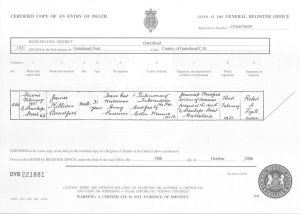
Marriage Certificate. George Marshall Bradford & Mary Watson 1879.
Marriage Certificate. James William Bradford & Joannah Bell 1913.
A historic postscript. When George, Mary Ann and Elizabeth moved from Alnwick to the old Marsden Village where George presumably took up employment at the newly opened Whitburn Colliery it must have seemed like an exciting adventure for them. Moving into newly built cottages. Hilton Street was only one of four streets in the village in 1881 as the story of Marsden is told brilliantly at this website. Please read it. The village is no longer there being only one of three Category D mining villages, all of which were scheduled for demolition by Durham County Council, where the site clearance took place in the 1960’s. You cannot see it even from the aerial photo of the area which is shown here. Another reference to the colliery village of Marsden is to be found on a BBC Website here.
A Map of Bradford Places.

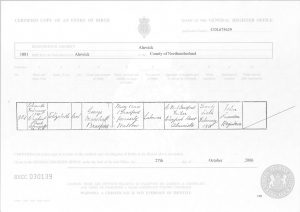
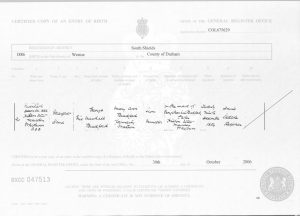
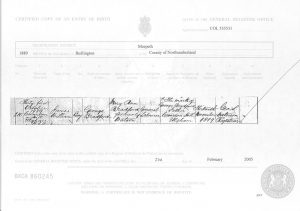

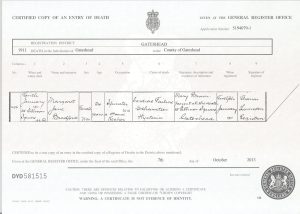
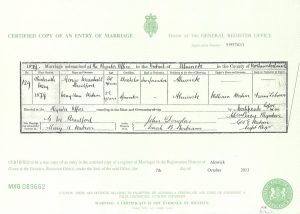
Leave a Reply